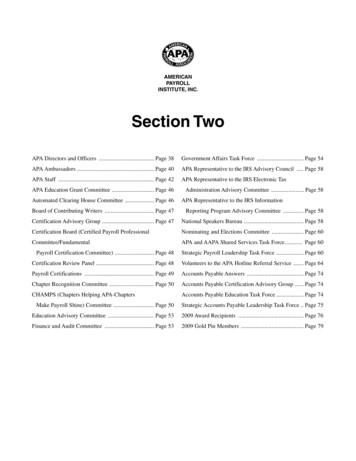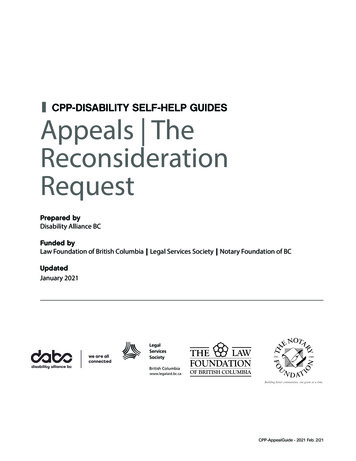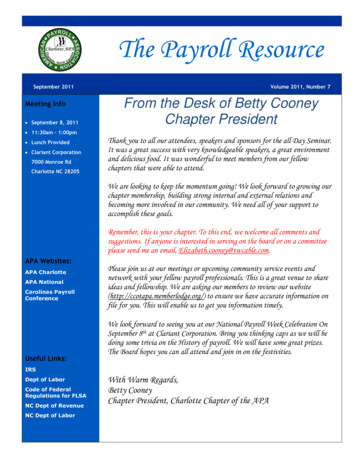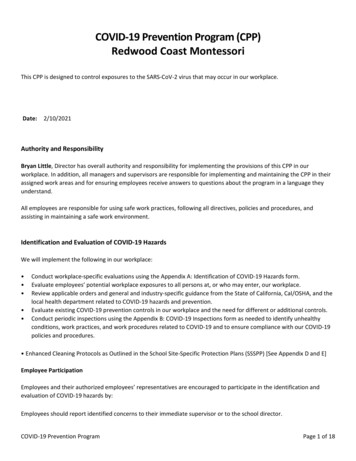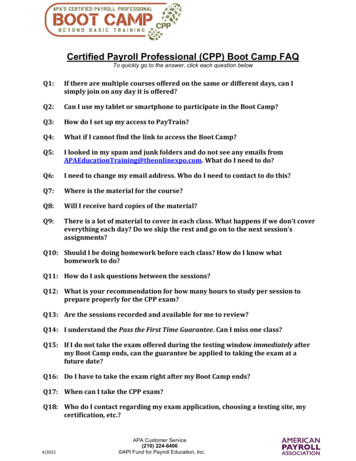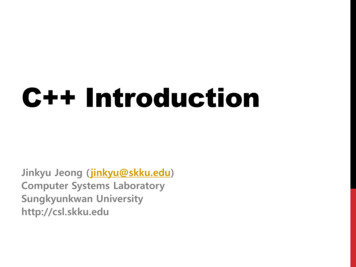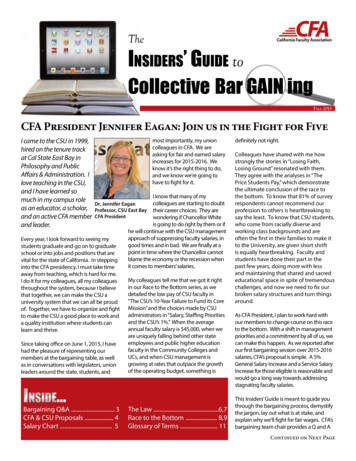
Transcription
TheInsiders’ Guide toCollective Bar GAIN ingFall 2015CFA President Jennifer Eagan: Join us in the Fight for FiveI came to the CSU in 1999,hired on the tenure trackat Cal State East Bay inPhilosophy and PublicAffairs & Administration. Ilove teaching in the CSU,and I have learned somuch in my campus roleas an educator, a scholar,and an active CFA memberand leader.most importantly, my unioncolleagues in CFA. We areasking for fair and earned salaryincreases for 2015-2016. Weknow it’s the right thing to do,and we know we’re going tohave to fight for it.Every year, I look forward to seeing mystudents graduate and go on to graduateschool or into jobs and positions that arevital for the state of California. In steppinginto the CFA presidency, I must take timeaway from teaching, which is hard for me.I do it for my colleagues, all my colleaguesthroughout the system, because I believethat together, we can make the CSU auniversity system that we can all be proudof. Together, we have to organize and fightto make the CSU a good place to work anda quality institution where students canlearn and thrive.Since taking office on June 1, 2015, I havehad the pleasure of representing ourmembers at the bargaining table, as wellas in conversations with legislators, unionleaders around the state, students, andInside.I know that many of mycolleagues are starting to doubttheir career choices. They arewondering if Chancellor Whiteis going to do right by them or ifhe will continue with the CSU managementapproach of suppressing faculty salaries, ingood times and in bad. We are finally at apoint in time where the Chancellor cannotblame the economy or the recession whenit comes to members’ salaries.Dr. Jennifer EaganProfessor, CSU East BayCFA PresidentBargaining Q&A . 3CFA & CSU Proposals . 4Salary Chart . 5My colleagues tell me that we got it rightin our Race to the Bottom series, as wedetailed the low pay of CSU faculty in“The CSU’s 10-Year Failure to Fund its CoreMission” and the choices made by CSUadministrators in “Salary, Staffing Prioritiesand the CSU’s 1%.” When the averageannual faculty salary is 45,000, when weare uniquely falling behind other stateemployees and public higher educationfaculty in the Community Colleges andUCs, and when CSU management isgrowing at rates that outpace the growthof the operating budget, something isThe Law .6,7Race to the Bottom . 8,9Glossary of Terms . 11definitely not right.Colleagues have shared with me howstrongly the stories in “Losing Faith,Losing Ground” resonated with them.They agree with the analyses in “ThePrice Students Pay,” which demonstratethe ultimate conclusion of the race tothe bottom. To know that 81% of surveyrespondents cannot recommend ourprofession to others is heartbreaking tosay the least. To know that CSU students,who come from racially diverse andworking class backgrounds and areoften the first in their families to make itto the University, are given short shriftis equally heartbreaking. Faculty andstudents have done their part in thepast few years, doing more with lessand maintaining that shared and sacrededucational space in spite of tremendouschallenges, and now we need to fix ourbroken salary structures and turn thingsaround.As CFA President, I plan to work hard withour members to change course on this raceto the bottom. With a shift in managementpriorities and a commitment by all of us, wecan make this happen. As we reported afterour first bargaining session over 2015-2016salaries, CFA’s proposal is simple. A 5%General Salary Increase and a Service SalaryIncrease for those eligible is reasonable andwould go a long way towards addressingstagnating faculty salaries.This Insiders’ Guide is meant to guide youthrough the bargaining process, demystifythe jargon, lay out what is at stake, andexplain why we’ll fight for fair wages. CFA’sbargaining team chair provides a Q and AContinued on Next Page
CFA Bargaining TeamStanding, from left: Susan Meisenhelder (San Bernardino), David Bradfield (Dominguez Hills), Richard Francisco (San Jose),Mark Karplus (East Bay), Molly Talcott (Los Angeles), Kathy Sheffield (Lead Negotiator/Director of Representation), CecilCanton (Sacramento), Lois Boulgarides (Sacramento), Kelly Janousek (Long Beach), Antonio Gallo (Northridge), TessnimAhmad (Research Specialist). Seated, from left: Ed Purcell (Consultant), Lillian Taiz (Los Angeles), Jennifer Eagan (EastBay), Kevin Wehr (Sacramento), Jonathan Karpf (San Jose), Kristin Eldridge (General Manager). Not pictured: Michele Barr(Fullerton), Steven Filling (Stanislaus), Andy Merrifield (Sonoma), Charles Toombs (San Diego).President’s MessageContinued from Page 1of frequently asked questions that beginson Page 3. If you’re interested in the salarystructure for all of Unit 3 members, you’llfind the chart on page 5. On page 11, wehave a glossary that should come in handyany time you read or talk about bargainingand salary increases.Throughout the process, we want to hearfrom you. Please get in touch with yourchapter leaders or email me at CFA@calfac.org. I hope that you’ll join mein the fight so that we can succeed ingetting what we deserve. We need all ofour members to be engaged—to knowwhat is at issue and to commit to joiningus as we take our fight to the Chancellor,as we likely will in November.2There’s an App for that!Your Union.At your fingertips.The latest in bargaining news [Information from your local CFA chapter [Weekly updates from CFA’s Headlines [Legislation and politics [News from our councils, committees and caucuses [[To download: Open the web browser on your smartphone and go to www.calfac.org. The mobile versionof the site will load. Add the CFA App button to yourhomescreen: With the app open, tap the export box onthe bottom of the screen. Then tap “Add to homescreen.”
Q AQ: What is Collective Bargaining?A: Collective Bargaining is thenegotiation of terms and conditions ofemployment between the union and theemployer. In our world, it is the processof negotiating salary, benefits, lecturerrights, workload, and other terms ofemployment with the management ofthe California State University (CSU).Q: Who represents faculty inbargaining?A: The California Faculty Association,or CFA for short. In 1983 CFA won anelection to be the exclusive bargainingagent for Bargaining unit 3. CFA isaffiliated with the American Associationof University Professors (AAUP), NationalEducation Association/CaliforniaTeachers Association (NEA/CTA), andService Employees International Union(SEIU).Q: What is Bargaining Unit 3?A: Unit 3 is made up of CSU Faculty –instructional faculty in the tenure lineas well as lecturers, coaches, counselors,and librarians. We work on all 23 of theCSU campuses, we number 25,000, andwe are employed in full- and part-timeappointments.Q: Who actually does thebargaining?A: The bargaining team is made upof faculty members from campusesthroughout the state who workcollaboratively to develop and advanceproposals at the bargaining table.The Bargaining Team also relies onconsultants and CFA professional stafffor chief negotiator and researcher. Weare also served by CFA staff and memberleaders who work on communicationsand organizing. The CFA Presidentappoints a chair and selects thebargaining team. She relies on therecommendations of CFA’s leadership,committees, and caucuses (www.calfac.org/groups). *See page 2 for a list ofbargaining team members.on Collective Bargaining with Kevin Wehr, Bargaining Team Chair (Sociology, Sacramento)Q: Who bargains for CSUmanagement?A: Currently, the CSU’s chief negotiatoris the Associate Vice Chancellor of LaborRelations who is joined by membersof management from the Chancellor’sLabor Relations Office and often a coupleof campuses (Fresno and San Luis Obispoin 2014).Q: What is Reopener Bargaining?A: In Fall 2014, we were unable to cometo agreement on salary for years two(2015-16) and three (2016-17) of theCollective Bargaining Agreement (CBA):The CSU management team simplywould not move from a 2% increase forthe 2015-2016 and 2016-2017 AcademicYears. So, we agreed to come back tothe table this year to negotiate for thesalary for 2015-2016 Academic Year. Wealso agreed to “reopen” on the issue ofbenefits for faculty teaching in Extensionfor Credit. The rest of the CBA remains ineffect, and we will not bargain over anyother topics until the full CBA expires inJune 2017.Usually, when it comes to salary, theCSU management team requires extrapressure to come around to facultyproposals. In other words, there’s moreto bargaining than what happens at thebargaining table.Q: What do we hope to get out ofbargaining?A: We hope to convince the CSUmanagement team members that it isin their best interest to settle with uson our terms for improving salary forall faculty and benefits in Extensionfor Credit. The future of Californiadepends on an educated population,and our members make that possible.Q: What happens in bargainingsessions?A: At a typical session eachside presents proposalsand support (data, historylessons, compellingarguments, etc.) for theirproposals. The receivingparty considers proposals,asks questions, and oftenpresents counter proposals.The process allows bothsides to fully consider issues,and often the parties taketime to study and respond.With salary in particular, theparties will require severalsessions to hash out theirproposals, counter proposals,and points of conflict.3
ProposalsThe 2014-2017 collective bargaining agreement between CFA and the CSU Trustees calls for reopener bargaining in years two and three of the contract regardingArticle 31 (Salary). The CFA Bargaining Team met with CSU negotiators in June 2015 to begin contract talks for the second year (2015/16) of the contract.Year 2 proposals.For 2015/2016, CFA proposes a 5%General Salary Increase for all Unit 3members, as well as a 2.65% ServiceSalary Increase (SSI) for all SSI-eligibleUnit 3 members.CSUFor Fiscal Year 2015/2016,the CSU is proposing acompensation pool of 2%for Bargaining Unit 3, tobe distributed through thecollective bargaining process.CFA“CFA’s proposal is simple, reasonable, and gives our members something to fight for. A 5% GSI and an SSIfor those eligible would go a long way towards addressing stagnating faculty salaries.”—Dr. Kevin Wehr, CFA Bargaining ChairJust thetheFactsOn average, CSU faculty earn 45,000per year in pay before taxes and otherdeductions, with more than 50 percent of CSU faculty making less than 38,000 in gross earnings per year.Even if all faculty were working onfull-time contracts, the average salaryfor CSU faculty would have been 63,000 in Fall 2014.Source: Chancellor’s Office of California State University. Personnel/Payroll Information Management System (PIMS)Extract for October 2014. All Unit 3/Faculty Salaries. http://www.calstate.edu/hr/4
UNIT 3 FACULTY SALARIES AS OF MAY 2015This chart is for reference only and does not replace the CSU Salary Schedule.Increments of Monthly and Annual Salaries are not equal.AY/10-monthClass TitleMonthlySalaryAnnualSalaryAssistantLec LAssist ProfLec BSr Asst LibCoach 125,460131,424135,408141,876MinSSI MaxMaxInstructorLec AAsst LibCoach Asst12-monthAssoc ProfLec CAssoc LibCoachSSP-ARIIProfessorLec DLibrarianHead CoachSSP-ARIIIMinSSI MaxMaxCoach Spec MinMinMinSSI MaxMinSSI MaxCoach Spec MaxSSI MaxSSP-ARI MaxCoach MaxHead Coach MaxSSP-ARII MaxSSP-ARIII MaxMax(Chair Max)MaxMax(Chair Max)(Chair 40Note: The Unit 3 Faculty salary structure is comprised of ranges. The salary range for each classification/rank/range is defined by the minimum, SSImaximum, and maximum salary. The increments in this table should not be interpreted as steps.CSU Salary Schedule located at y.aspx.This document is adapted/updated from Office of Academic Personnel, Cal Poly, San Luis Obispo “Faculty Salaries at a Glance” (11-17-2013).Survey says: Majority of CSU facultydissatisfied with their salaryThis spring, CFA conducted a survey of allCalifornia State University faculty and receivedmore than 5,500 responses. Respondentsanswered questions on a range of salary issues,from take-home pay levels to how salary hasimpacted home-buying and other personalfinance decisions.See the complete results here:calfac.org/losing-ground-losing-faith5
The LawCalifornia’s Higher Education Employment Relations Act details the many steps by which public higher educationemployees and employers reach a fair contract.Start — Public NoticeSometimes referred to as “sunshining,” this is thefirst step in public sector bargaining in whichthe parties provide notice to the people ofCalifornia that we intend to bargain.BargainingImpasseIf the sides cannot reach agreement afterbargaining in good faith, HEERA (the actguaranteeing our right to collective bargaining)allows one or both sides to declare impasseand request to go to the next statutory stage ofbargaining—MEDIATION.[]AgreementThe sides reachconsensus.6 -( Teams for the union and the Chancellor’s teamengage in face-to-face negotiations. Bargainingcan take days, weeks, months, or even years.With just two topics—salary and benefits forExtension for Credit—we do not expect thispart of the statutory scheme to take as longas it takes to bargaining the full CollectiveBargaining Agreement (CBA).[]AgreementThe sides reachconsensus.MediationThe State Mediation and Conciliation Service assigns a mediatorto assist the parties to reach a voluntary resolution of theirdisagreements. The mediator meets individually and collectivelywith the parties in mediation sessions. When and if the mediatorconcludes that mediation cannot produce a settlement, he or shecertifies the dispute for the next step—FACTFINDING.
FactfindingFactfinding is an opportunity for both sides to make their caseto a 3-person panel that issues an advisory report. CFA and theChancellor’s team each select a factfinding panel member, andPERB provides a list of proposed neutral individuls from whichone is chosen. The panel hears evidence and examines the facts.Usually, factfinding results in a 2-to-1 opinion in favor of one orthe other party.) Factfinding Blackout[]AgreementThe sides reachconsensus.Concerted Action/StrikeBefore the parties can publicly share theFactfinder report, they must wait 10 days.During this “blackout” period, the parties maytry to settle the agreement without resorting topublic pressure. The publication of the report isthe final step in the statutory process.Once CFA has exhausted its efforts to reach an agreementand has complied with the statutory process, the unionmay call for concerted activities including a strike—thewithholding of our labor.and/orUnilateral ImpositionOnce the Chancellor’s team has compliedwith the statutory process, the Chancellormay impose his “last, best, and final offer”on the faculty. So far, that’s 2% which isnot enough for faculty to settle for.7
A four-part series of research examining theCSU administration’s priorities and the impacton faculty salaries, workload and students.Paper 1: CSU’s 10-year Failure toFund its Core MissionWhen compared to other universitysystems around the country, and toevery education segment in California,the CSU stands out for its unparalleledfailure to improve faculty salaries or evento protect them from the ravages ofinflation.Paper 2: Salaries, StaffingPriorities and the CSU’s 1%Over at least the last decade, CSUadministrators, like many corporateexecutives, have consistently andvigorously prioritized those at the top ofthe organizational hierarchy, while othersin the CSU have been left to languish.Faculty Spotlight:Althea WaitesShe is an acclaimed concert pianist and holds a master’s in music from Yale,yet Althea Waites doesn’t earn enough to get by teaching as a lecturer at CalState Long Beach. Waites supplements her monthly pay with freelancing andworking part-time as a church organist. While others her age typically retire,Waites doesn’t know if retirement will ever become a reality.“If you’re teaching part time, as I have been for all these years, there’s noway that I could live off of the retirement the university would pay me,”she said. “I don’t know what it’s going to take for the administration torealize that if they want to retain or keep good faculty coming in, as wellas providing for the younger teachers, they need to reward service andexcellence in salaries.”8
calfac.org/race-to-the-bottomPaper 3: Losing Ground andLosing FaithFor faculty in the CSU, things havechanged; that economic security hasbecome shaky for many, and for others,impossible. As a result, more and morefaculty in the CSU— tenured and lectureralike—are losing ground economicallyand losing faith in their institutions andin the future of their profession.Paper 4: The Price Students PayWhen faculty are not hired in sufficientnumbers or provided adequate salaries,students also pay a price. Unfortunately,that price is high.Read and download the papers:calfac.org/race-to-the-bottomFaculty Spotlight:Stephen CampbellDespite holding degrees from three universities, Dr. Stephen Campbell,a lecturer at Cal Poly Pomona, depends on food stamps and Medicaid attimes to get by. He teaches at a community college to supplement hisincome. He’s years away from even being able to think about starting afamily.He said he “can’t ethically recommend graduate school for anyone inhistory anymore.”9
10
CompressionofCompression happens when longserving faculty members do not progresswithin the salary ranges. Newer hirescome in at salaries that are closer tomarket (especially in the last few yearscoming out of the recession), and moreexperienced faculty find themselvesearning salaries that are very near,but slightly higher than their newercolleagues. It is also called an experiencepenalty.Equity Salary IncreasesEquity salary increases are targeted raisesthat are meant to correct compressionand inversion. Equity is necessary whenour members go years with no raises, orreceive small GSIs that do not adequatelyaddress in-range progression.Faculty Merit Increases (FMI)Faculty Merit Increases were awardedin 1998, 1999, and 2000. These raisesstill impact current salaries as theyare backed out for SSI eligibilityconsiderations.General Salary Increase (GSI)General Salary Increase are raises thatwe bargain for that apply to all facultymembers, usually at a percentage ratebased on an individual’s base salary.Higher Education EmployerRelations Act (HEERA)Higher Education Employer-EmployeeRelations Act, the labor act that gives CFAthe right to collectively bargain with theemployer. HEERA sets out the statutoryprocess that requires us to enter intomediation and factfinding if we areunable to reach an agreement at thebargaining table.InversionInversion happens when long-servingfaculty members find themselves earningless than their newer colleagues. Aswith compression, it is also called anexperience penalty.ProgressionThe process by which a faculty member’sTermspay increasesfrom the salaryminimum to theSSI max withineach salary range.In other settings,progressionhappensautomatically withstep increases each year of satisfactoryperformance, but the CSU has refusedto agree to regular, yearly progressionwhich has resulted in compression andinversion.RangeAn academic status used for lecturers.Ranges run from A through D and areanalogous to ranks for tenure-line facultymembers.Rankour members languished and foundthemselves stuck with no progressionwithin rank/range.Like steps in other job settings, thereare a limited number of SSIs available.Temporary faculty members are eligiblefor SSIs after earning 24 weightedteaching units (WTUs) (36 on quartercampuses) of service credit in onedepartment. However, in all cases, an SSIcan never adjust an individual’s salaryabove the SSI max.An academic status of a tenure linefaculty member. The ranks include FullProfessor, Associate Professor, AssistantProfessor and equivalent for counselorsand librarians.CFA has long maintained that SSIs arenot as costly as the CSU claims becauseof attrition (retirement and new hiresbalance out costs).Salary Recovery Adjustment (SRA)SSI MaxSalary Recovery Adjustments are salaryincreases provided in the 2014 contractfor faculty members whose salaries werebelow the SSI max in their salary ranges.SRAs for 2014-2015 were paid at 3% (orless for salaries close to the SSI max).Service Salary Increase (SSI)Service Salary Increases are salaryincreases paid at the rate of 2.65%. Theyare increases within the salary rank/rangeand assist our members to progresswithin a salary rank/range.The maximum salary within a range orrank that a faculty members can reachthrough receipt of SSIs.More on the Contract:calfac.org/2014-2017-contractWhile other state employees have steps(regular, yearly salary increases untilthey reach the max within a range), thecurrent salary structure for CSU facultyworks differently. Progression onlyoccurs when CSU management agrees toit, and especially in the recession years,11
thgFi12sseniraFrfosetesurfTodraoBUSC@November 17, 2015Long BeachInfo: calfac.org
compensation pool of 2% for Bargaining Unit 3, to be distributed through the collective bargaining process. "CFA's proposal is simple, reasonable, and gives our members something to fight for. A 5% GSI and an SSI for those eligible would go a long way towards addressing stagnating faculty salaries." —Dr. Kevin Wehr, CFA Bargaining Chair


